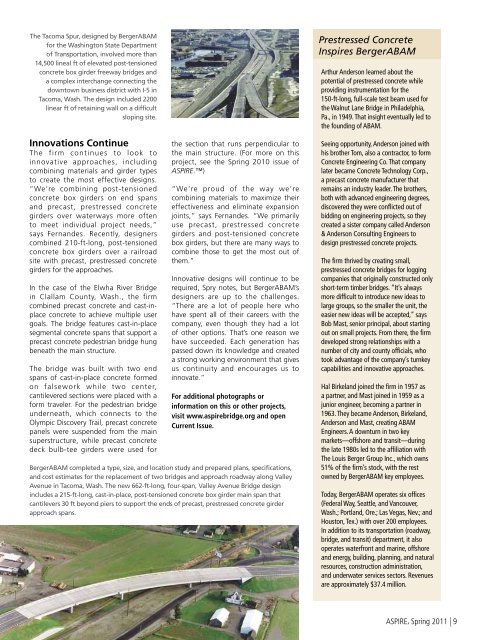ASPIRE Spring 11 - Aspire - The Concrete Bridge Magazine
ASPIRE Spring 11 - Aspire - The Concrete Bridge Magazine
ASPIRE Spring 11 - Aspire - The Concrete Bridge Magazine
Create successful ePaper yourself
Turn your PDF publications into a flip-book with our unique Google optimized e-Paper software.
<strong>The</strong> Tacoma Spur, designed by BergerABAMfor the Washington State Departmentof Transportation, involved more than14,500 lineal ft of elevated post-tensionedconcrete box girder freeway bridges anda complex interchange connecting thedowntown business district with I-5 inTacoma, Wash. <strong>The</strong> design included 2200linear ft of retaining wall on a difficultsloping site.Innovations Continue<strong>The</strong> firm continues to look toinnovative approaches, includingcombining materials and girder typesto create the most effective designs.“We’re combining post-tensionedconcrete box girders on end spansand precast, prestressed concretegirders over waterways more oftento meet individual project needs,”says Fernandes. Recently, designerscombined 210-ft-long, post-tensionedconcrete box girders over a railroadsite with precast, prestressed concretegirders for the approaches.In the case of the Elwha River <strong>Bridge</strong>in Clallam County, Wash., the firmcombined precast concrete and cast-inplaceconcrete to achieve multiple usergoals. <strong>The</strong> bridge features cast-in-placesegmental concrete spans that support aprecast concrete pedestrian bridge hungbeneath the main structure.<strong>The</strong> bridge was built with two endspans of cast-in-place concrete formedon falsework while two center,cantilevered sections were placed with aform traveler. For the pedestrian bridgeunderneath, which connects to theOlympic Discovery Trail, precast concretepanels were suspended from the mainsuperstructure, while precast concretedeck bulb-tee girders were used forthe section that runs perpendicular tothe main structure. (For more on thisproject, see the <strong>Spring</strong> 2010 issue of<strong>ASPIRE</strong>.)“We’re proud of the way we’recombining materials to maximize theireffectiveness and eliminate expansionjoints,” says Fernandes. “We primarilyuse precast, prestressed concretegirders and post-tensioned concretebox girders, but there are many ways tocombine those to get the most out ofthem.”Innovative designs will continue to berequired, Spry notes, but BergerABAM’sdesigners are up to the challenges.“<strong>The</strong>re are a lot of people here whohave spent all of their careers with thecompany, even though they had a lotof other options. That’s one reason wehave succeeded. Each generation haspassed down its knowledge and createda strong working environment that givesus continuity and encourages us toinnovate.”For additional photographs orinformation on this or other projects,visit www.aspirebridge.org and openCurrent Issue.BergerABAM completed a type, size, and location study and prepared plans, specifications,and cost estimates for the replacement of two bridges and approach roadway along ValleyAvenue in Tacoma, Wash. <strong>The</strong> new 662-ft-long, four-span, Valley Avenue <strong>Bridge</strong> designincludes a 215-ft-long, cast-in-place, post-tensioned concrete box girder main span thatcantilevers 30 ft beyond piers to support the ends of precast, prestressed concrete girderapproach spans.Prestressed <strong>Concrete</strong>Inspires BergerABAMArthur Anderson learned about thepotential of prestressed concrete whileproviding instrumentation for the150-ft-long, full-scale test beam used forthe Walnut Lane <strong>Bridge</strong> in Philadelphia,Pa., in 1949. That insight eventually led tothe founding of ABAM.Seeing opportunity, Anderson joined withhis brother Tom, also a contractor, to form<strong>Concrete</strong> Engineering Co. That companylater became <strong>Concrete</strong> Technology Corp.,a precast concrete manufacturer thatremains an industry leader. <strong>The</strong> brothers,both with advanced engineering degrees,discovered they were conflicted out ofbidding on engineering projects, so theycreated a sister company called Anderson& Anderson Consulting Engineers todesign prestressed concrete projects.<strong>The</strong> firm thrived by creating small,prestressed concrete bridges for loggingcompanies that originally constructed onlyshort-term timber bridges. “It’s alwaysmore difficult to introduce new ideas tolarge groups, so the smaller the unit, theeasier new ideas will be accepted,” saysBob Mast, senior principal, about startingout on small projects. From there, the firmdeveloped strong relationships with anumber of city and county officials, whotook advantage of the company’s turnkeycapabilities and innovative approaches.Hal Birkeland joined the firm in 1957 asa partner, and Mast joined in 1959 as ajunior engineer, becoming a partner in1963. <strong>The</strong>y became Anderson, Birkeland,Anderson and Mast, creating ABAMEngineers. A downturn in two keymarkets—offshore and transit—duringthe late 1980s led to the affiliation with<strong>The</strong> Louis Berger Group Inc., which owns51% of the firm’s stock, with the restowned by BergerABAM key employees.Today, BergerABAM operates six offices(Federal Way, Seattle, and Vancouver,Wash.; Portland, Ore.; Las Vegas, Nev.; andHouston, Tex.) with over 200 employees.In addition to its transportation (roadway,bridge, and transit) department, it alsooperates waterfront and marine, offshoreand energy, building, planning, and naturalresources, construction administration,and underwater services sectors. Revenuesare approximately $37.4 million.<strong>ASPIRE</strong>, <strong>Spring</strong> 20<strong>11</strong> | 9
















